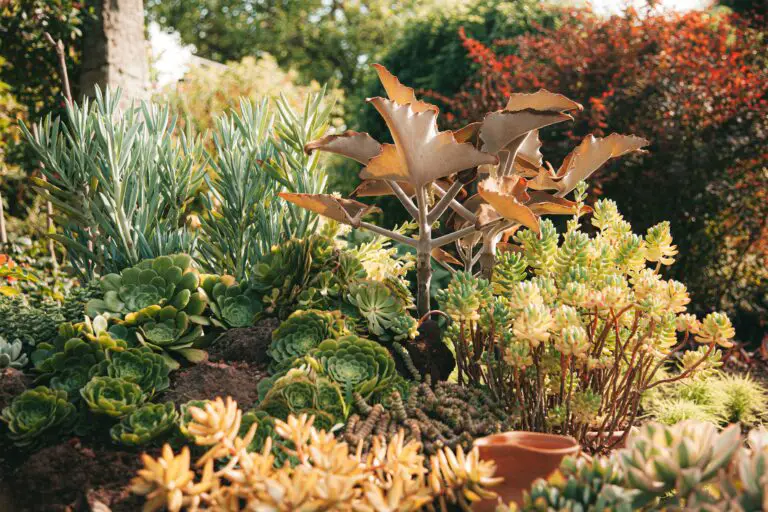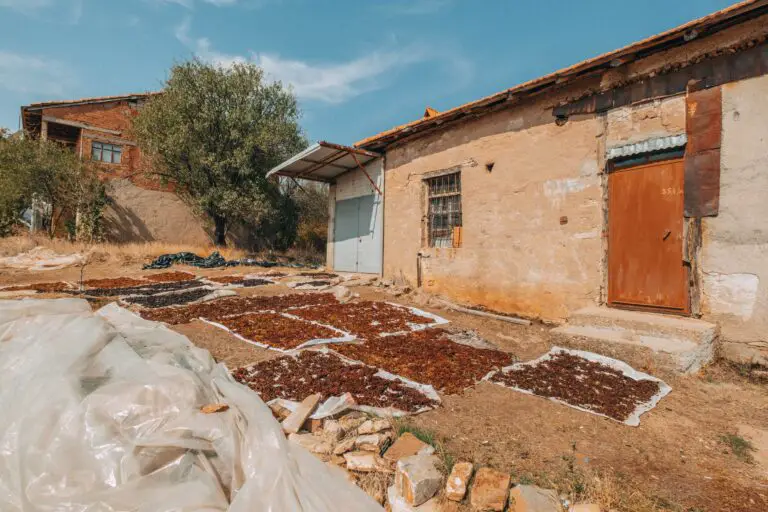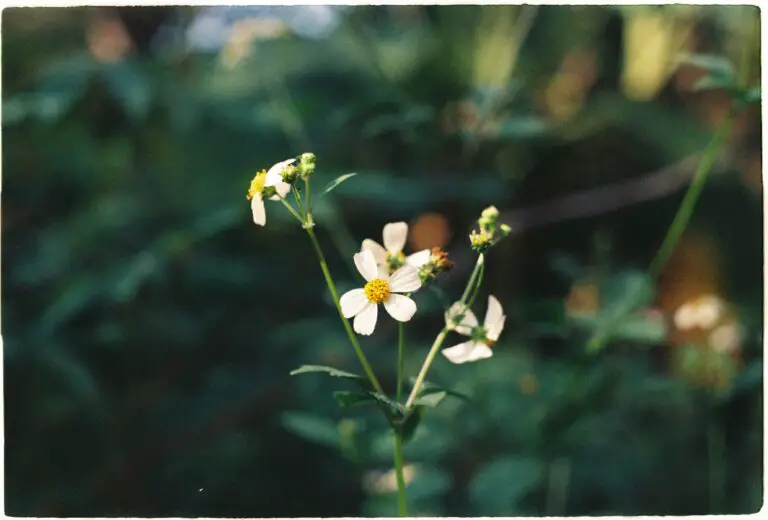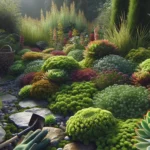Introduction to Sedums
Imagine a garden that brims with vibrancy, a symphony of foliage that thrives through the scorch of summer and the chill of winter. Sedums, the resilient heroes of such gardens, offer a carousel of color that enchants the eye and fortifies the soul. Known for their striking forms and unmatched hardiness, sedums are a plant enthusiast’s delight, presenting a palette of textures that range from the plump, water-storing leaves of Sedum morganianum to the starry flower clusters of Sedum telephium.
With their global popularity, sedums have nestled into the hearts of gardeners across continents. Whether sprawling across a sunny rockery or perched atop a living wall, these plants boast an architectural quality that captures admiration. In a casual stroll through a well-curated garden, one might encounter sedums in an array of roles: thrillers in container compositions, spillers cascading over edges, or fillers providing a lush carpet underfoot.
Let’s dive into the world of sedums, where their perennial nature weaves stories of growth year after year. These are not fleeting annuals that bow out after a single season. Instead, they persist, evolve, and flourish, carving out their forever place in our gardens and in our affections. Watch as this video tutorial guides you through the springtime care of these enduring beauties, bringing practical expertise to your fingertips.
For those who’ve just begun their gardening journey, fear not the perceived complexities. The sedum’s agreeable nature makes it an accessible choice for beginners, as validated by the expert tips provided in the highly informative Sedum Plant Care & Growing Guide. Its undemanding roots ask for little yet give so much, making it a testament to endurance and an embodiment of nature’s persistent quest for life.
Indeed, sedums are forever flourishing, their life cycle a captivating display of resilience and beauty. From their sprightly spring emergence to their serene winter slumber, these perennials witness the cyclical dance of the seasons, standing as a verdant reminder of the ever-turning wheel of life.
Defining the Terms: Annuals vs Perennials
Cue the botanical showdown – it’s time to settle the green debate on annuals and perennials. Gardening enthusiasts, listen up! These aren’t just fancy terms; they hold the secret to the lifespan of your lush companions. Understanding these categories will turn you into a savvy green-thumbed individual, guiding you through the world of blooming beauties and flourishing flora.
Annuals: These are the sprinters of the plant kingdom, bursting onto the scene with a mission to grow, bloom, and seed all in one go – talk about a one-year wonder! Ever witnessed the vibrant marigolds or petunias gracing the gardens in summer? That’s them living their best, albeit brief, life.
Perennials: In contrast, perennials are the marathon runners, pacing themselves to come back year after year. These steadfast plants include the likes of lavender and peonies, establishing their roots in your garden for an encore every season. Their tenacity offers a lasting relationship with your garden beds, one that evolves and strengthens with each passing year.

Why does this matter, you ask? Knowing the difference is crucial for designing a garden that delivers perennial pleasure or annual awe. It impacts everything from how you invest your time and resources to how you craft the aesthetic journey of your backyard oasis.
For a more in-depth dive into cultivating these garden gems, you might want to explore this splendid source, offering treasures of tailored tips and inspiration for your verdant ventures.
Let’s not forget – the rhythm of replanting annuals every year or the joy of greeting perennials as old friends is an experience unique to your garden’s dynamic theatre. Whether you’re planting for pollinators or dreaming up a perennial paradise, nature’s script is yours to write!
The Perennial Nature of Sedums Explained
Sedums, those hardy and diverse succulents, are more than just mere garden beauties—these resilient plants prove year after year that they’re in it for the long haul. So are sedums annuals or perennials, you ask? It’s high time we put this question to rest once and for all. Sedums are, without a doubt, perennials. Let’s unravel the hearty constitution of these enduring plants that allows them to rise like a phoenix from one growing season to the next.
Think of sedums as the marathon runners of the plant world. Where some plants might wave the white flag in the face of frost or hang their heads in the blistering heat, sedums stand tall. Their succulent leaves hoard water like a camel’s hump, allowing them to shrug off droughts with nonchalance. This adaptation bestows upon them a robustness that carries them through various climates.
But to truly appreciate the perennial prowess of these green warriors, we must dive into the real-life feats they accomplish. Envision a Sedum ‘Autumn Joy’, its thick, fleshy leaves harboring moisture, summoning clusters of vibrant pink flowers that mature into a rich, copper hue as summer fades into fall. As winter casts its chill, the topmost growth may retreat, but beneath the surface, the roots dwell secure and undaunted, ready to launch a new onslaught of verdant growth when spring whispers its return.
Sedums are not only survivors; they thrive, spreading their reach and deepening their roots with each passing year. Take, for instance, a Sedum album, commonly known as White Stonecrop—each fragment that falls from the mother plant has the potential to colonize a new terracotta realm, becoming a lush, living tapestry that paints a dramatic picture across your garden year after year.
For a closer look at the sedum’s remarkable lifecycle, feast your eyes on this informative and visually striking video:
Understanding the perennial nature of sedums can help gardeners and enthusiasts alike to not only appreciate these plants’ resilience but also ensure their frequent return. Proper sedum care, from the right watering techniques to the appropriate soil mix, plays a pivotal role in cultivating a garden that not only survives but flourishes with these perennial champions as its cornerstone.
Consider this next time you stroll by a bed of sedums or spot a pot perched on a sunny sill: these plants aren’t just growing—they’re claiming their immortal stake in the landscape, season after season. With their innate capacity to endure, sedums truly embody the essence of perpetual life in the plant kingdom.
Varieties of Sedums: A Spectrum of Lifespans
When you wander through the garden centers, it’s easy to spot sedums, with their chunky leaves and stout stems, mingling cheerfully among other plants. They’re the easy-going friends in the plant world—low maintenance, adaptable, and, most notably, perennials that grace your garden year after year. But what about the whole spectrum of sedums out there? Do some deviate from the perennial promise?
Indeed, the sedum family is diverse, with over 400 species ranging from creeping groundcovers to upright clumps resembling small shrubs. Some, like Sedum acre (‘Goldmoss’), are fast-growing and can effortlessly carpet an area with their star-shaped blooms, while others such as Sedum telephium (‘Autumn Joy’) proudly display cabbage-like rosettes that burst into fall colors. While these examples are quintessentially perennial, returning after each winter, there are outliers worth noting.

Consider the annual sedum species—yes, they do exist! Sedum rubrotinctum (‘Pork and Beans’), for instance, is often treated as an annual in colder climates. Without the cozy blanket of a greenhouse or indoors, it may not survive the frosty farewell of fall. On the other hand, in warmer zones, these annual types may persist and behave more like perennials. Nature loves to blur the lines, doesn’t she?
To broaden your gardening horizons even further, swing by our comprehensive guide on eco-friendly gardening with sedums, which delves into creating vibrant landscapes with these versatile succulents.
So, are sedums forever flourishing in their perennial glory? Mostly, yes—with a few exceptions that remind us of nature’s variety and adaptability. Embrace the diversity, and maybe experiment with both perennial and the rarer annual varieties in your garden for year-round intrigue and charm!
Cultivating Sedums: Care, Propagation, and Year-Round Tips
Embark on a journey through the captivating world of sedums, where each plant tells its own verdant tale of survival and splendor. In this segment, we’ll dig into the nitty-gritty of nurturing your resilient leafy companions. From the perfect Earthy bed to bathe their roots to the golden kiss of sunlight they crave—let’s explore the art of ensuring these hardy succulents aren’t just annual guests in your gardens, but perennial partners in your green-thumbed adventures.

Grounding Your Greens: Soil Secrets for Sedum Success
As tenacious as they are, sedums have a soft spot for well-drained soil. Imagine their roots like little underground explorers, yearning for a terrain that’s akin to a crumbly treasure trove, rich yet airy. A loamy or sandy sanctuary does wonders, allowing excess moisture to bid a hasty retreat, so you won’t find your sedums’ toes steeping in unwanted dampness.
Sunlight: The Golden Thread in the Tapestry of Sedum Health
Picture sedums as sun-worshipping mounds, basking in the glow of the celestial fireball overhead. These plants are die-hard fans of full sun, though they won’t scoff at a bit of shade. In a sun-drenched corner of your garden, they’ll unfurl their leaves and bloom in triumphant color, like living, breathing jewels dotting your outdoor realm.
Aqua Amore: Quenching Thirst Without Drowning Dreams
The watering can is a potent tool—a wielder of life but also a potential bringer of soggy doom. Sedums require a sip, not a gulp, and they implore you to let the rainclouds do most of the quenching. When you do water, think of it as a gentle sprinkle, a refreshing mist that caresses the leaves and soaks just enough to sate their thirst.
Propagation: The Circle of Sedum Life
The magic of propagation transforms a single sedum into a community, a leaf or stem cutting into a burgeoning plant. This is where gardening feels like alchemy; a snippet here, a portion there, and voilà, a new generation arises. Lay them upon the soil like a velvet cloak for the earth, and watch as roots tentative, then tenacious, thread through the ground to anchor new life.
From the forgiving beginner gardener to the seasoned green fingers, cultivating sedums is a dance with nature that rewards patience with a spectacle of sheer resilience and evergreen beauty. So, let’s raise our trowels and toast to the perennial promise of the delightful sedums in our midst.
The Advantages of Perennials in Your Garden
Imagine your garden, brimming with sedums: their lush foliage and vibrant blooms a testament to nature’s resilience. Herein lies the beauty of perennials, the hardy heroes of horticulture. Sedums, the stalwarts that they are, boast a life cycle that stretches far beyond the fleeting presence of annuals. Let’s delve deep into the perennial powers that make sedums an eco-smart and economically savvy choice for gardeners.
In the economic realm, sedums are a thrift shopper’s dream. Unlike their annual counterparts which require yearly purchases, sedums settle in for the long haul. After the initial investment, these perennials cut costs by returning year after year, saving both your wallet and your back from the toil of replanting every spring. But it’s not just about the cost-saving; it’s also the time-saving. Time spent nurturing sedums is an investment with compound interest, gifting more free hours to enjoy the fruits of your labor in future seasons.

Environmentally, sedums are nothing short of an ecological boon. These perennials enhance biodiversity, inviting a cavalcade of pollinators. Bees buzz with delight, butterflies dance, and other beneficial insects thrive, all thanks to the sedums’ extended blooming periods. The roots of sedums dig deep, fortifying the soil against erosion and fostering a healthy underground ecosystem. The garden, under the watchful leaves of sedums, becomes a micro-haven for wildlife, a tiny but mighty fortress against the creeping desolation of habitat loss.
Real-life examples abound, bringing these advantages into sharp relief. That neighbor with the envy-inducing garden? Chances are, perennials like sedums are her secret. She knows that once established, these plants weather the caprice of climate, from scorching summers to biting winters, with stalwart grace. They transform her garden into a perennial paradise, a tapestry of color that evolves but never fades, even when autumn whispers sweet promises of decay.
Sedums: The Economy and Ecology Made Vivacious
Ultimately, the question “are sedums annuals or perennials” opens up a world where perennials reign supreme. From their economic sensibility to their ecological benefits, sedums exemplify the perennial philosophy: that which endures, enriches. Whether you’re a gardening greenhorn or a green-thumbed guru, embracing sedums in your garden is to embrace a legacy of growth, bounty, and unending vibrancy.
Common Misconceptions About Sedums and Perennial Plants
When it comes to sedums, there’s a garden of myths that need uprooting. So, let’s dig into the truth about these versatile plants and put to rest the question on everyone’s mind: are sedums annuals or perennials? Sedums, with their fleshy leaves and captivating flowers, are indeed perennial plants. They’re the stalwarts of the garden, returning year after year to lend their unique beauty to our outdoor spaces.
One misconception that needs clearing is the idea that perennials, including sedums, are high-maintenance. In reality, sedums are some of the most low-maintenance plants you can invite into your garden. They’re drought-tolerant troopers that thrive with minimal fuss. Unlike annuals, which bid farewell after one season, sedums will grace your garden with their presence for many years, provided they’re in a sunny spot with well-drained soil.
It’s commonly believed that perennials like sedums have a short blooming time. However, sedums offer a long-lasting display of color, from the bright greens of spring to the deep rusts and purples that herald the approach of autumn. For instance, take the ‘Autumn Joy’ variety, which unfurls its pink flowers in the late summer and retains its appeal well into the cooler months, a stunning example of perennials’ extended allure.
Many imagine that perennials can’t survive harsh winters, yet sedums are incredibly hardy. These rugged beauties can weather frost and snow, popping back up when the warmth of spring kisses the earth. Sedums are survivors, persisting where other plants might falter, making them exemplary members of the perennial family.
Another myth to bust is that sedums don’t change over time. Even though they’re perennials, sedums can evolve in your garden, spreading to form larger clumps or changing in color intensity with the seasons. This ability to adapt and grow makes sedums a dynamic and valuable addition to your perennial palette.
To enrich our understanding, let’s take a visual journey exploring these enduring plants. The following video illuminates the differences between annual and perennial plants, with insights that apply directly to our beloved sedums.
Lastly, there’s this idea that you’re limited in variety when it comes to perennial plants. Yet, the world of sedums is a vast one, full of diverse shapes, sizes, and colors. From ground-hugging creepers to stately upright varieties, sedums prove that perennials offer an abundance of choices for the discerning gardener. So, it’s time to do away with the myths and celebrate the resilient and diverse nature of sedums and their perennial kin.
Frequently Asked Questions
When it comes to the enchanting world of sedums, gardeners and plant lovers alike often find themselves pondering over a multitude of questions. Well, fret not! We’re about to dive into a treasure trove of information that’ll shed light on these resilient and ever-charming succulents. Let’s get to the root of your curiosity!
Are Sedums Annuals or Perennials?
The debate around whether sedums are annuals or perennials is quite common, and the answer is quite delightful – most sedums are perennials! These hardy little troopers come back year after year, flaunting their succulent leaves and star-shaped blooms. Imagine a garden where sedums, once planted, continue to spread joy with their presence for many seasons to come. That’s the perennial promise of sedums, and it’s a beautiful one!

What Should I Know About Sedum Care?
Caring for sedums is as easy as pie – or should we say as easy as tending to a cactus in the desert! These low-maintenance beauts thrive on neglect. They prefer well-draining soil and plenty of sunshine, much like a sunbather on a beach. Water them sparingly, and watch as they reward you with lush foliage and vibrant colors. It’s like having a garden that mostly takes care of itself – every gardener’s dream!
Are There Different Varieties of Sedums?
Just like the stars in the sky, there are numerous varieties of sedums to admire. From the ground-hugging ‘Dragon’s Blood’ to the upright and statuesque ‘Autumn Joy’, there’s a sedum for every garden scene. Imagine having a ‘Chocolate Drop’ sedum that adds a touch of dark foliage drama or a ‘Blue Spruce’ sedum that brings a pop of cool blue-green to your landscape tapestry. The diversity amongst sedums is truly astounding, offering a palette of options for the creative gardener.
As we uncover the secrets behind the enduring charm of sedums, we invite you to ponder these FAQs and incorporate these resilient plants into your garden narrative. With their perennial power and diverse forms, sedums stand as a testament to nature’s enduring beauty and adaptability. Now that’s a garden story worth telling!



